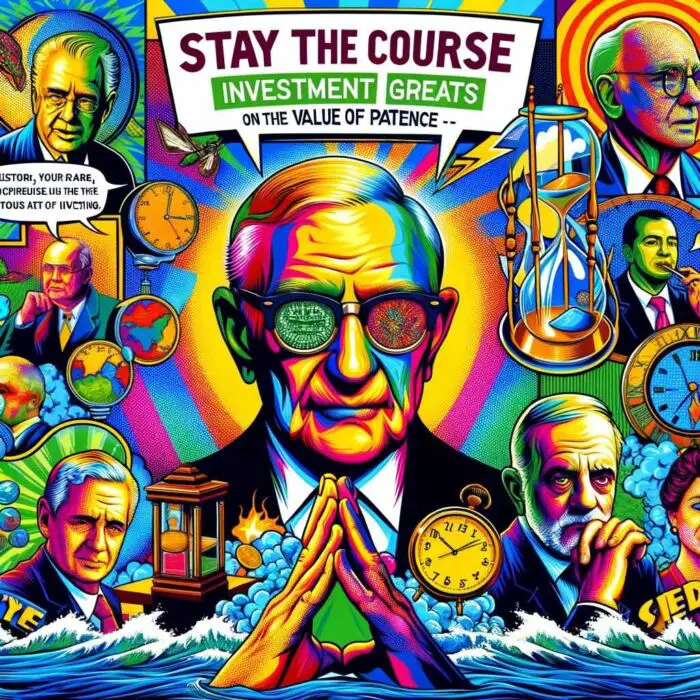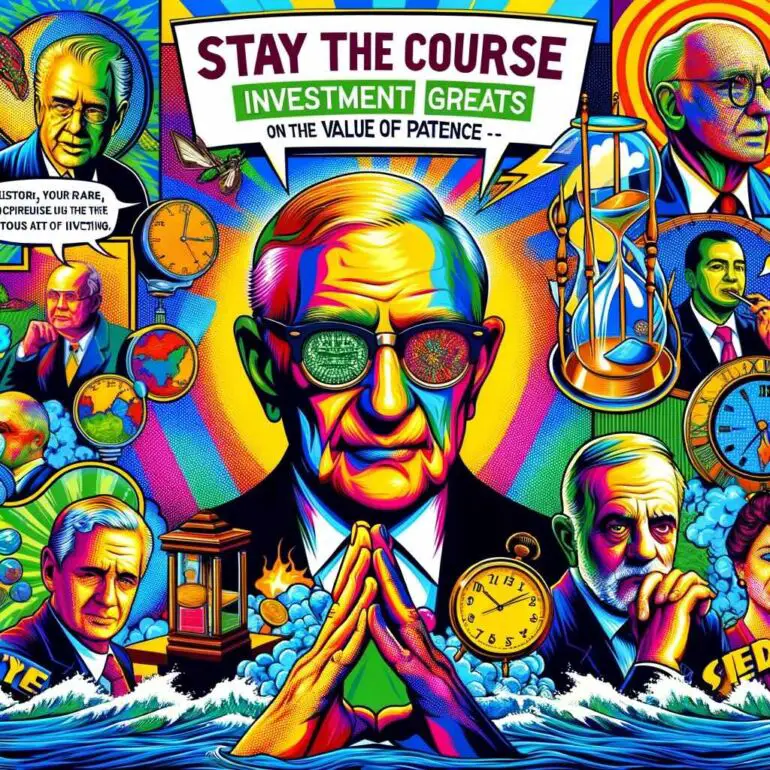In the cacophonous whirl of the investment world, where a multitude of voices clamor for our attention every second, there emerges a time-tested mantra that remains impervious to the ebb and flow of market tides: patience. While contemporary market trends are fleeting, dominated by algorithmic trading and minute-by-minute news updates, the importance of patience as a virtue in investing cannot be overstated. As an investor, the temptation to react to every price movement, every new piece of information, can be overwhelming. Yet, it is in resisting these ephemeral distractions and committing to a long-term perspective that true investment legends have built their fortunes and legacies.

Importance of Patience in Investing
The realm of investing is no stranger to the allure of quick gains and the thrill of short-term speculation. However, every seasoned investor knows that the real magic, the genuine alchemy of wealth accumulation, occurs over time. It’s akin to planting a seed and nurturing it diligently, allowing it the time to grow, branch out, and eventually bear fruit. This philosophy is not a recent epiphany; it has been championed by some of the most iconic figures in the investment world.

Well-Known Investment Figures
In this discourse, we will navigate through the profound insights of these investment luminaries, individuals who have not only amassed substantial wealth but have also illuminated the path for countless others with their wisdom. These include the Oracle of Omaha, Warren Buffett; the insightful Peter Lynch; the innovative Philip Fisher; and the resilient Sir John Templeton, to name just a few. Each of them, in their unique ways, have underscored the paramount significance of patience in the world of investing.
While each of these figures had their own strategies and styles, a common thread wove through their investment philosophies: the conviction that one’s investment decisions should not be dictated by the capriciousness of the market, but rather by a steadfast commitment to a well-thought-out strategy, grounded in patience and long-term vision.
As we delve deeper into their wisdom and explore the depths of their insights, it will become evident that patience is not just a passive act of waiting. It’s an active discipline, a conscious choice to see beyond the myopic confines of the present and into the vast expanse of the future. It’s about understanding that the true value of an investment may not be immediately apparent and that the most potent returns often require the most prolonged gestation.
Let’s embark on this journey, learning from the greats, appreciating the art of patience, and understanding how it can be our most potent ally in the intricate dance of investing.

The Essence of Patience in Investing
At the heart of every successful investment story lies an often understated, yet profoundly impactful principle: patience. It is a characteristic that, on the surface, seems passive. In reality, it’s an active, deliberate, and strategic choice made by investors who understand the difference between fleeting moments and lasting value.

The Role of Patience in Long-term Success
- Compound Interest – The Eighth Wonder of the World: Albert Einstein famously said, “Compound interest is the eighth wonder of the world. He who understands it, earns it; he who doesn’t, pays it.” Compound interest is the process where the value of an investment increases because the earnings on both the principal amount and the accumulated earnings from previous periods are reinvested. This mechanism can only manifest its full potential over time. Patience allows investors to reap the rewards of compounding, turning small, consistent contributions into sizeable sums.
- Emotional Equilibrium: The financial markets are a volatile space, prone to drastic fluctuations influenced by myriad factors. A patient investor doesn’t get swayed by short-term market noise. Instead, they maintain their emotional equilibrium, making decisions based on fundamentals and long-term prospects rather than immediate sentiments.
- Research and Analysis Pay-off: Good investing is often predicated on thorough research and analysis of companies, sectors, and economic trends. This meticulous groundwork helps in identifying potential investment opportunities that may not bear fruit immediately but promise substantial returns in the future. Patience ensures that all this effort doesn’t go to waste, allowing time for the research to manifest its worth.
- Avoiding the Cost of Frequent Transactions: Every time one buys or sells a security, there are associated transaction costs. Overactive trading can erode the capital base, especially if the gains from these frequent transactions don’t significantly outpace the costs. Patience curtails this unnecessary expenditure, promoting a buy-and-hold strategy that historically has proven to be more cost-effective and lucrative.

The Distinction: Trading vs. Investing
The terms ‘trading’ and ‘investing’ are often used interchangeably, but they represent two distinct approaches to the financial markets:
- Time Horizon: The most evident distinction is the time horizon. Traders usually operate on a short-term basis, holding onto securities for minutes, hours, or days. Investors, on the other hand, have a longer time-frame, often spanning years or even decades.
- Objective: Traders seek to exploit market inefficiencies or short-term price movements. They capitalize on volatility, momentum, and trends. Investors, conversely, are more interested in the underlying value of assets. They base their decisions on thorough analysis of fundamentals, believing that over time, the market will recognize and appropriately value the intrinsic worth of these assets.
- Risk Profile: Due to the short-term nature of trading, it’s often accompanied by higher risks. Rapid market movements can result in substantial gains or losses in a short span. Investing, while not immune to risks, tends to be more buffered against daily market volatilities due to its long-term nature.
- Decision Metrics: Traders often employ technical analysis, studying price patterns, and using various indicators to predict future price movements. Investors predominantly use fundamental analysis, examining financial statements, industry trends, and broader economic indicators to assess an asset’s value.
- Emotional Component: Trading requires swift decisions, often in the heat of the moment, and can be emotionally intense. Investing, grounded in patience, provides a buffer against impulsive decisions driven by fear or greed.
Investing vs Trading
While both trading and investing have their merits and pitfalls, they underscore the significance of patience in two ways. For the trader, patience might mean waiting for the right market conditions or entry and exit points. For the investor, it’s a more profound commitment to a vision, a belief in the enduring value of assets, and the discipline to wait, often years, to see one’s convictions validated.
source: Financial Policy Council on YouTube

Warren Buffett: Titan of Patience and Prudence
Warren Buffett, often colloquially known as the “Oracle of Omaha,” stands as one of the most celebrated figures in the investment universe. Born in 1930 in Omaha, Nebraska, Buffett displayed a proclivity for numbers and business from a very young age. As the chairman and CEO of Berkshire Hathaway, a conglomerate holding company, he has consistently showcased an investment prowess that has made him one of the world’s wealthiest individuals.

Buffett’s Investment Philosophy
Buffett’s investment philosophy is grounded in the principles of value investing, a strategy pioneered by his mentor, Benjamin Graham. The core tenets of this philosophy can be outlined as follows:
- Intrinsic Value Over Market Price: Buffett’s investment decisions revolve around the concept of intrinsic value. He seeks businesses that he believes are priced below their true worth. While the market price of a stock can be influenced by a plethora of transient factors, the intrinsic value provides a more accurate reflection of a business’s actual worth. Buffett’s knack lies in identifying this disparity and capitalizing on it.
- Long-term Holding: Buffett is famously known for his buy-and-hold strategy. He often quips that his favorite holding period is “forever.” This perspective aligns perfectly with his belief in patience as an invaluable trait in investing. By committing to a company for the long haul, he bypasses the short-term volatilities and gains from the company’s overall growth over time.
- Quality Over Quantity: Warren Buffett emphasizes the importance of investing in high-quality businesses – those with a durable competitive advantage, ethical management, and a clear operational model. He believes that it’s better to buy a wonderful company at a fair price than a fair company at a wonderful price.
- Economic Moats: One of Buffett’s signature concepts is the idea of an “economic moat.” Just as a moat protects a castle from invaders, an economic moat protects a business from competitors. This could be in the form of brand recognition, patents, regulatory advantages, or any other factor that provides a company with a competitive edge.
- Fear and Greed Contrarianism: Buffett advises being fearful when others are greedy and greedy when others are fearful. He sees market downturns not as threats, but as opportunities to buy quality stocks at discounted prices.
Buffett in His Own Words
The two provided quotes beautifully encapsulate the essence of Buffett’s philosophy:
- “The stock market is a device for transferring money from the impatient to the patient.”
- This quote underscores the emphasis Buffett places on patience in investing. He believes that the stock market, with its inherent volatility, tends to favor those who can resist the urge for immediate gratification and wait for their investments to mature over time.
- “Someone’s sitting in the shade today because someone planted a tree a long time ago.”
- A poetic way to capture the essence of long-term vision and the rewards of patience. Just as a tree takes time to grow and provide shade, investments often require time to mature and yield returns. The immediate benefits we reap today are often the result of foresight, diligence, and patience exercised in the past.
Warren Buffett is not just an investor; he’s a teacher. His life and investment strategies serve as invaluable lessons in patience, prudence, and the art of seeing beyond the immediate to grasp the potential of the future. Through his wisdom, we are reminded that in the world of investing, just as in life, patience is not merely a virtue; it’s a strategy.
source: WEALTHTRACK on YouTube

Benjamin Graham: The Progenitor of Value Investing
In the annals of investment history, few figures loom as large as Benjamin Graham. Born in 1894 in London and later migrating to the United States, Graham’s influence on the investment world is profound and enduring. Not only did he lay down the foundational principles of value investing—a discipline that has shaped countless successful investment careers—but he also mentored future luminaries like Warren Buffett, instilling in them the virtues of patience, discipline, and rationality.
Graham was not just an investor; he was a scholar and educator. A graduate of Columbia University, he later returned to teach there, imparting his knowledge and wisdom to eager students. His seminal works, “Security Analysis” (co-written with David Dodd) and “The Intelligent Investor,” are often heralded as the bibles of value investing, packed with insights that remain relevant to this day.

Graham’s Investment Philosophy
- Margin of Safety: At the core of Graham’s philosophy is the concept of the “margin of safety.” This principle dictates that one should only invest in a security when its market price is significantly below its intrinsic value. This differential provides a cushion against potential losses and unforeseen adverse developments.
- Rational Analysis: Graham firmly believed that investment decisions should be grounded in thorough and rational analysis rather than emotions or prevailing market sentiments. By relying on objective data and sound evaluation, an investor can mitigate risks and make informed choices.
- Focus on the Business, Not the Stock: Graham emphasized the importance of evaluating a company’s actual business operations, assets, and earnings potential rather than getting swayed by stock price movements or market speculation.
- Defensive vs. Enterprising Investing: In “The Intelligent Investor,” Graham outlines two approaches—defensive (or passive) investing and enterprising (or active) investing. Defensive investors aim for steady returns with minimal effort, often investing in indexes or well-established companies. Enterprising investors, on the other hand, are willing to dedicate time and effort to find undervalued securities, often leading to higher potential returns, but with increased effort and risk.
Graham in His Own Words
- “The investor’s chief problem—and even his worst enemy—is likely to be himself.”
- With this quote, Graham touches upon the psychological challenges faced by investors. Emotional responses, be they fear during market downturns or greed during booms, can lead investors astray. By identifying that the greatest adversary is often one’s own impulses and biases, Graham highlights the importance of self-awareness and discipline in the investment journey.
- “In the short run, the market is a voting machine, but in the long run, it is a weighing machine.”
- This insightful analogy delineates the difference between short-term market fluctuations and long-term value realization. In the short term, stock prices can be influenced by popularity contests, speculative bubbles, or transient news. However, over time, the true value of a company—its assets, earnings, and growth potential—will determine its stock price. As such, Graham urges investors to focus on this “weight” or intrinsic value rather than getting caught up in the ephemeral “votes” of the market.
Benjamin Graham’s legacy is a testament to the timelessness of his principles. In an ever-evolving financial landscape, his teachings serve as a beacon, guiding investors towards rationality, diligence, and patience. His emphasis on the intrinsic value of assets and the importance of a margin of safety has shaped the investment approaches of generations, ensuring that his wisdom continues to resonate and guide even in the contemporary investment world.
source: The Financial Times on YouTube

Charlie Munger: The Intellectual Counterpart to the Oracle of Omaha
Charlie Munger, while perhaps not as universally recognized as Warren Buffett, is undeniably one of the sharpest minds in the world of investing. Born in 1924 in Omaha, Nebraska, Munger’s intellectual breadth extends beyond just finance; he’s well-versed in disciplines ranging from psychology to philosophy, and he leverages this multidisciplinary understanding to inform his investment decisions.
As the Vice Chairman of Berkshire Hathaway, Munger has been Buffett’s right-hand man for decades. Their partnership is legendary, often characterized by a synergy wherein Munger’s rigorous logical reasoning complements Buffett’s intuitive grasp of businesses. While Buffett might be the more vocal face of Berkshire, Munger’s influence on its investment philosophy and decisions is undeniable.

Munger’s Investment Philosophy
- Latticework of Mental Models: One of Munger’s most distinctive contributions to the world of investing is his emphasis on a “latticework of mental models.” He advocates for understanding the fundamental principles from various disciplines and then using this interdisciplinary knowledge to make better investment decisions. For Munger, a deep understanding of human psychology, economics, and business is just as crucial as financial metrics when evaluating a potential investment.
- Simplicity Over Complexity: While Munger appreciates the value of a broad knowledge base, he’s also a firm believer in simplicity. He often emphasizes the importance of identifying and focusing on the most significant factors in any investment decision, rather than getting bogged down by every minute detail.
- Avoiding Stupidity: Munger often speaks about the value of avoiding mistakes rather than trying to be overly smart. For him, sidestepping obvious pitfalls and maintaining rationality in the face of market irrationality is often more beneficial than chasing after the next big thing.
- Patience and Long-Term Vision: As the provided quote underscores, Munger is a staunch advocate for patience in investing. He believes in the virtue of sitting on investments, allowing them to mature and compound over time, rather than hopping from one opportunity to the next.
Munger in His Own Words
- “The big money is not in the buying and selling. But in the waiting.”
- This quote encapsulates Munger’s belief in the power of compounding and the merits of a long-term investment horizon. Instead of trying to time the market or capitalize on short-term fluctuations, Munger believes that the real wealth is generated by holding onto good investments over extended periods, allowing their intrinsic value to unfold and compound.
- “It is remarkable how much long-term advantage people like us have gotten by trying to be consistently not stupid, instead of trying to be very intelligent.”
- In this quote, Munger emphasizes the importance of rationality and avoiding blunders. While the investment world is often enamored with genius moves and brilliant strategies, Munger suggests that simply steering clear of obvious mistakes and maintaining a consistent, logical approach can lead to superior long-term outcomes.
Charlie Munger’s contributions to the investment landscape are profound. His emphasis on interdisciplinary learning, simplicity, and the art of not being stupid offers a refreshing perspective in a world often obsessed with complexity and rapid moves. Munger’s wisdom serves as a reminder that, at its core, successful investing is as much about character, patience, and clear thinking as it is about financial acumen.
source: Investor Talk on YouTube

Peter Lynch: The Magician of Mutual Funds
Few individuals in the annals of investing can claim to have achieved the levels of consistent success that Peter Lynch did during his tenure at the helm of Fidelity’s Magellan Fund. Born in 1944 in Newton, Massachusetts, Lynch’s investment journey began at a young age, leading him to become one of the most revered fund managers in history.
From 1977 to 1990, under Lynch’s stewardship, the Magellan Fund boasted an average annual return of nearly 29%, making it the best performing mutual fund in the world during that time. This prodigious success was a result not of serendipity but of a meticulous, grounded, and uniquely Lynchian approach to stock picking.

Lynch’s Investment Philosophy
- Invest in What You Know: Peter Lynch is famously known for his adage, “Invest in what you know.” He believed that individual investors had the potential to spot valuable investment opportunities in their daily lives well before Wall Street took notice. Whether it was a favorite restaurant chain or a widely-used product, Lynch argued that personal experiences could provide invaluable insights into promising stocks.
- Growth Over Value: While many of his contemporaries focused on value investing, Lynch was primarily a growth investor. He looked for companies with strong and sustainable growth prospects, regardless of whether they were currently undervalued or overvalued by traditional metrics.
- Stalwarts, Slow Growers, and Fast Growers: Lynch categorized companies based on their growth profiles. “Stalwarts” were large companies with dependable growth, “slow growers” were typically larger, more established firms with modest growth prospects, and “fast growers” were smaller, more nimble companies with explosive growth potential. Each category required a different investment approach.
- The P/E Ratio as a Guidepost: For Lynch, the price-to-earnings (P/E) ratio was more than just a financial metric; it was a key barometer of a stock’s potential. He often compared a company’s P/E ratio to its expected growth rate to ascertain whether it was over or undervalued.
- Understanding the Story: Lynch believed in understanding the narrative behind each company. What did they do? What made them unique? What challenges and opportunities lay ahead? This qualitative analysis was as vital to him as any balance sheet or income statement.
Lynch in His Own Words
- “The real key to making money in stocks is not to get scared out of them.”
- Markets are inherently volatile, and stocks will always have their ups and downs. This quote underlines Lynch’s belief that investors should remain committed to their convictions, even when faced with temporary setbacks or market downturns. Succumbing to fear and making hasty decisions often means missing out on subsequent rebounds and long-term growth.
- “You get recessions, you have stock market declines. If you don’t understand that’s going to happen, then you’re not ready, you won’t do well in the markets.”
- Here, Lynch highlights the cyclicality of economies and markets. Recessions and declines are inevitable parts of the financial landscape. Instead of fearing these downturns, successful investors should anticipate and prepare for them. This understanding and readiness allow for a more measured, rational approach to investing, even in turbulent times.
Peter Lynch’s investment philosophy, marked by its blend of personal insights and rigorous analysis, has left an indelible mark on the world of finance. His belief in the individual investor’s potential, coupled with his emphasis on understanding both the qualitative and quantitative aspects of a company, offers a holistic approach to stock picking. In a world where markets often oscillate between euphoria and panic, Lynch’s wisdom stands as a timeless testament to the virtues of understanding, patience, and conviction.
source: Investor Archive on YouTube

Sir John Templeton: The Vanguard of Global Investing
In the constellation of investment greats, Sir John Templeton shines brightly as a pioneering figure who championed the idea of seeking investment opportunities beyond one’s own shores. Born in 1912 in the small town of Winchester, Tennessee, Templeton’s journey from his humble beginnings to becoming one of the most influential global investors is a testament to his foresight, open-mindedness, and indomitable spirit.
Founder of the Templeton Growth Fund in 1954, Templeton’s investment approach was characterized by a rare blend of global curiosity and rigorous value orientation. By venturing where others hesitated, be it post-war Japan in the 1950s or emerging markets in subsequent decades, Templeton’s audacious bets often paid off handsomely, cementing his reputation as an investment savant.

Templeton’s Investment Philosophy
- Global Diversification: At a time when many investors were fixated on domestic markets, Templeton recognized the vast potential that lay overseas. He believed in the importance of diversifying across countries and sectors, a strategy that often led him to uncover hidden gems in unexpected places.
- Value Orientation: Despite his global perspective, Templeton was a value investor at heart. He meticulously searched for companies trading below their intrinsic value, believing that such undervalued stocks offered a margin of safety and significant upside potential.
- Contrarian Approach: Templeton wasn’t one to follow the crowd. He often zagged when others zigged, buying into countries or sectors that were out of favor but held promise in his analysis. This contrarian stance required immense courage and conviction but frequently yielded impressive results.
- Spiritual Influence: A deeply spiritual man, Templeton believed in the interplay of spirituality and business. He felt that principles of integrity, humility, and gratitude were essential components of any successful investment philosophy.
- Long-Term Horizon: Templeton understood that the real fruits of investment are often reaped in the long term. He had the patience to wait for his investment theses to play out, often holding onto stocks for extended periods to realize their full potential.
Templeton in His Own Words
- “The four most dangerous words in investing are: ‘This time it’s different.’”
- With this quote, Templeton warns against the pitfalls of over-optimism and the tendency to ignore historical patterns. Throughout financial history, bubbles have been justified with the belief that the old rules no longer apply, only for such bubbles to inevitably burst. Templeton underscores the importance of learning from history and approaching new paradigms with a healthy dose of skepticism.
- “The time of maximum pessimism is the best time to buy, and the time of maximum optimism is the best time to sell.”
- Here, Templeton encapsulates the essence of contrarian investing. When pessimism abounds, assets are often undervalued, presenting buying opportunities. Conversely, unchecked optimism can lead to overvaluations, signaling a good time to sell. For Templeton, the mood of the masses was often a contrarian indicator, guiding him to make decisions that ran counter to prevailing sentiment.
In the annals of investment history, Sir John Templeton stands out not just for his impressive track record, but also for the breadth of his vision. He saw a world teeming with opportunities, unbounded by geographic or sectoral confines. His lessons on global diversification, value investing, and contrarian thinking remain profoundly relevant, serving as guiding lights for investors navigating the complex tapestry of global markets.
source: Excess Returns on YouTube

Larry Swedroe: The Crusader of Evidence-Based Investing
While many legendary investors rose to prominence based on their stock-picking acumen or contrarian views, Larry Swedroe has carved out a unique niche for himself as a steadfast advocate for evidence-based investing. Born in the latter half of the 20th century, Swedroe’s impact on the world of finance is defined not by audacious bets on individual stocks but by his unwavering commitment to grounding investment decisions in empirical evidence and robust research.
As a principal and the Chief Research Officer for Buckingham Strategic Wealth, Swedroe has been instrumental in shaping the firm’s approach to wealth management. Buckingham Strategic Wealth is recognized for its data-driven, client-centric philosophy, and much of this ethos can be attributed to Swedroe’s influence.

Swedroe’s Investment Philosophy
- Empirical Foundation: At the heart of Swedroe’s investment approach is an uncompromising belief in the power of evidence. Rather than relying on speculation, gut instinct, or market trends, Swedroe stresses the importance of making decisions based on rigorous academic research and empirical data.
- Efficient Market Hypothesis (EMH): Swedroe is a staunch proponent of the EMH, which posits that markets are typically efficient in reflecting all available information. As a result, consistently outperforming the market, especially after accounting for fees and taxes, is a challenging endeavor.
- Diversification Over Speculation: In line with his evidence-based approach, Swedroe emphasizes the importance of diversifying investments across asset classes and geographies. By doing so, investors can mitigate risks and enhance the probability of achieving more consistent returns over time.
- Skepticism of Forecasting: Swedroe is notably skeptical of anyone’s ability to consistently and accurately predict market movements. He believes that while short-term market fluctuations can be influenced by a myriad of unpredictable factors, over the long term, markets tend to reward patient, disciplined investors.
- Cost Matters: Recognizing the erosive impact of fees on investment returns, Swedroe champions cost-efficient investment vehicles like index funds or ETFs. His philosophy underscores that minimizing costs is one of the few variables investors can control, and it plays a pivotal role in net returns.
Swedroe in His Own Words
- “While it’s easy to invest, succeeding at investing is a totally different matter.”
- This quote encapsulates the distinction between the mere act of investing and the art of successful investing. The barriers to entry in the investment world might be low, but navigating the complex waters of the financial markets and achieving consistent success requires discipline, knowledge, and an adherence to sound principles.
- “There are two kinds of forecasters: those who don’t know, and those who don’t know they don’t know.”
- A nod to the inherent unpredictability of the markets, this quote underscores Swedroe’s skepticism towards market predictions. It’s a wry observation of the overconfidence that sometimes pervades the financial industry, where prognosticators often speak with unwarranted certainty about future events.
In the ever-evolving tapestry of the investment world, Larry Swedroe stands as a beacon for those who believe in the merits of a systematic, evidence-based approach. His philosophy, emphasizing rigorous research, diversification, and cost consciousness, offers a grounded and pragmatic path for investors navigating the uncertain terrains of the financial markets. In a realm often influenced by noise and speculation, Swedroe’s voice is a clarion call for rationality and discipline.
source: The Meb Faber Show on YouTube

William Bernstein: The Neurologist Who Deciphered Finance
In the galaxy of financial luminaries, William Bernstein’s star shines distinctively bright, not solely because of his contributions to investment theory but because of the unconventional path he traversed. Starting his professional life not in the corridors of Wall Street but in the meticulous realm of neurology, Bernstein’s segue into finance was driven by a profound curiosity and a desire to understand, rather than simply partake in, the world of investing.
The Unlikely Investor
Dr. William Bernstein’s credentials as a neurologist were indisputable. Practicing medicine and understanding the intricate web of human neurology require analytical rigor, patience, and an unyielding commitment to evidence. It was these very skills, honed in the operating rooms and clinics, that Bernstein brought to bear upon the financial markets.
His journey into finance was organic. Beginning as a personal quest to better manage his investments, it soon burgeoned into a passion, with Bernstein immersing himself in economic history, investment theory, and portfolio management.
The Author and Educator
Bernstein’s transition from neurology to finance wasn’t merely about personal wealth accumulation. He felt a deep-seated responsibility to share his insights and educate the broader public about the intricacies of investing. This led him to pen several influential books on finance and economic history. Some of his seminal works include “The Four Pillars of Investing” and “A Splendid Exchange.” These writings demystify complex financial concepts, blending historical anecdotes with rigorous analysis to offer readers both context and clarity.

Bernstein’s Philosophical Nuggets
- “When you’ve won the game, why keep playing?”
- This quote succinctly captures the essence of risk and reward in investing. Once an investor has accumulated sufficient wealth to meet their goals, the imperative shifts from wealth accumulation to wealth preservation. The risks that one might have taken when building a nest egg are not necessarily the same risks one should take when that nest egg has reached its target size. In essence, once you’ve achieved your financial goals, it might be prudent to adopt a more conservative stance rather than continually chasing higher returns.
- “The reason that ‘guru’ is such a popular word is because ‘charlatan’ is so hard to spell.”
- With his characteristic wit, Bernstein highlights the pitfalls of placing undue faith in self-proclaimed financial ‘gurus’. The financial world is replete with individuals claiming to have unique insights or proprietary strategies. However, as history has shown, few can consistently outperform the market, and many are more interested in their own gain than in the welfare of their clients. This quote is a cautionary reminder to investors to maintain a healthy skepticism and conduct thorough due diligence.
Dr. William Bernstein stands as a testament to the idea that passion, coupled with rigorous inquiry, can lead one to mastery in even the most unexpected of fields. His journey from neurology to finance, underpinned by an educator’s zeal, has enriched the investment community. His writings, imbued with a blend of historical depth and practical wisdom, serve as invaluable guides for both novice and seasoned investors navigating the labyrinthine world of finance.
source: The Swedish Investor on YouTube

Howard Marks: The Maestro of Market Cycles
In the orchestra of investing greats, Howard Marks conducts a unique melody, one that resonates with the ebbs and flows of market cycles and the intricate dance of risk and reward. With a career spanning several decades, Marks has solidified his place as not just a successful investor but as a profound thinker whose insights into market behavior have become a touchstone for investors globally.
Oaktree Capital and The Memos
In 1995, along with Bruce Karsh and a few other partners, Howard Marks co-founded Oaktree Capital Management, an investment firm that would go on to become one of the leading authorities in the world of distressed debt investing. But beyond the firm’s financial acumen and impressive track record, one of its most influential contributions to the investment community has been Marks’ periodic memos to Oaktree clients.
These memos, which Marks began penning even before Oaktree’s inception, are a blend of astute market commentary, timeless investment wisdom, and insightful observations about investor behavior. Over time, they’ve garnered a global following, eagerly anticipated and dissected by professionals and amateurs alike. For many, these writings offer a rare window into the thought processes of a master investor, balancing between the immediacies of current events and the timelessness of overarching investment principles.

Marks’ Investment Philosophy
- Risk Management: Central to Marks’ investment strategy is the understanding and management of risk. While many investors are primarily concerned with returns, Marks emphasizes the importance of recognizing the risks undertaken to achieve those returns. He believes that understanding and controlling risk is a key determinant of long-term success in investing.
- Understanding Market Cycles: Marks is acutely aware of the cyclical nature of markets. He stresses that investors should not only recognize where they stand in a cycle but also anticipate potential future shifts. This cyclical perspective underpins many of Oaktree’s investment decisions, guiding when to be aggressive and when to be defensive.
- The Psychological Aspect: Marks often delves into the psychological elements of investing. He believes that understanding human behavior, especially during times of greed and fear, can offer investors an edge. Recognizing and mitigating one’s own biases is as crucial as understanding market fundamentals.
Marks in His Own Words
- “In investing, what is comfortable is rarely profitable.”
- With this statement, Marks touches on a fundamental truth in investing. The most lucrative opportunities often arise when the majority is fearful or overlooks them. Venturing outside one’s comfort zone, while ensuring risks are understood and managed, can lead to outsized rewards.
- “The biggest investing errors come not from factors that are informational or analytical, but from those that are psychological.”
- Here, Marks underscores a central tenet of his philosophy – the primacy of psychology in investing. Even the most astute analysis can be undermined by emotions such as panic during downturns or exuberance during booms. For Marks, mastering one’s own psychology is integral to investment success.
In the vast realm of finance, Howard Marks stands as a beacon of wisdom and insight. His nuanced understanding of risk, deep appreciation of market cycles, and emphasis on the psychological dimensions of investing make him a unique figure in the investment world. Through his writings and the work of Oaktree Capital, Marks continues to impart invaluable lessons, urging investors to think deeply, act judiciously, and always be cognizant of the balance between risk and reward.

Lessons Derived from Their Wisdom
In the annals of investment history, each era births its own legends, figures whose philosophies transcend the circumstances of their times, offering perennial lessons to all who care to heed them. From the writings and experiences of the aforementioned greats—Buffett to Marks—we can distill a series of timeless insights that serve as guiding stars in the tumultuous skies of the investment world.

The Long-View Approach
The Benefits of a Long-Term Perspective: Investing isn’t a sprint; it’s a marathon. Our luminaries consistently emphasize the importance of patience, reminding us that the most significant rewards often accrue to those who can look beyond the vicissitudes of the present. Whether it’s Buffett’s tree planted long ago offering shade today or Marks’ cyclical understanding of markets, the lesson is clear: it’s the ability to maintain a long-term perspective that distinguishes the truly exceptional investor.
Application: Instead of getting caught up in daily market movements or short-term disruptions, investors would benefit from framing their investment objectives in terms of decades rather than months or years.

The Illusion of Market Timing
The Perils of Trying to Time the Market: As much as we’d like to believe in the fantasy of buying at the absolute bottom and selling at the zenith, the reality is that even the best often can’t predict these points with consistent accuracy. Peter Lynch famously remarked on the inevitability of market declines, and Bernstein jests about the fallacy of financial ‘gurus’. The consensus? It’s not about timing the market, but time in the market.
Application: Instead of attempting to jump in and out based on predictions, a more effective strategy may involve consistent investing—taking advantage of dollar-cost averaging and allowing compound interest to work its magic.
The Emotional Rollercoaster
How Emotions Like Fear and Greed Can Sabotage an Investment Strategy: The emotional tug-of-war that investing can elicit is among the most formidable challenges an investor faces. Fear and greed, as Howard Marks articulates, are not just incidental; they lie at the heart of many investing missteps. Whether it’s the panic-induced selling during a downturn or the exuberant overbuying in a booming market, emotions, left unchecked, can be the Achilles’ heel of even the most astute investor.
Application: Cultivate an awareness of one’s emotional responses. Question impulsive decisions. Is that sell order a result of careful analysis or a knee-jerk reaction to a headline? By recognizing the emotional traps, one can navigate them more adeptly.
Informed, Not Impulsive
The Advantage of Staying Informed and Avoiding Impulsive Decisions: Sir John Templeton warned of the perils of thinking, “this time it’s different,” while Swedroe championed evidence-based investing. The common thread? The importance of continuous learning, staying informed, and ensuring decisions are grounded in data and not swayed by the prevailing sentiment of the moment.
Application: Make a habit of regular financial education, whether it’s through books, seminars, or trusted financial news sources. An informed investor is better equipped to discern between fleeting trends and genuine opportunities.
In sum, the insights from these investing titans serve as a roadmap, guiding us through the complexities of the financial world. Their collective wisdom reminds us that while the specifics of investing might evolve—the principles, those bedrock tenets that underpin success, remain steadfast. Investing, as they show us, is as much a test of character and discipline as it is of acumen and strategy.

Modern Application: Patience in the Digital Age
In an age characterized by the rapid dissemination of information, 24/7 news cycles, and the lure of viral trends, the timeless tenets of patience and long-term thinking in investing seem to be under siege more than ever. The modern digital age, with all its advancements and conveniences, has also ushered in challenges for the patient investor. Navigating these waters requires both an awareness of these challenges and a resolve to adhere to foundational investment principles.
The Whirlwind of the News Cycle
Challenges and Distractions: No longer do investors wait for the morning paper or the evening news for their financial updates. With smartphones, alerts, and countless platforms, we’re inundated with financial news, speculation, and punditry around the clock. While staying informed is crucial, the sheer volume and incessant nature of today’s news pose a unique challenge: discerning vital information from noise.
Application: Investors must become adept at curating their information sources. Not every piece of news warrants a change in strategy. Learning to filter out the noise and focusing on material developments related to investments can help investors maintain their course without getting swayed by every gust of news.

The Mirage of Instant Wealth
Temptation of Quick Profits: The age of the internet has seen the rise of viral stocks and meme investing. Stories of individuals amassing fortunes overnight from trending stocks flood social media and online forums. While such tales can be exhilarating, they present a skewed picture, often downplaying the risks involved and painting investing as a game of quick gains.
Application: Remember Peter Lynch’s words: “You get recessions, you have stock market declines.” The allure of instant wealth should be weighed against the very real risks. A diversified portfolio, grounded in research and a clear understanding of one’s risk tolerance, remains a prudent approach.
A Clarion Call to the Basics
Returning to Research, Understanding, and Waiting: In a world of instant gratification, the virtues of diligence and patience seem almost archaic. But as the investing greats have shown, these principles endure across ages and market conditions. Whether it’s Buffett’s advocacy for understanding a company thoroughly or Graham’s insistence on intrinsic value, the basics remain as relevant today as they ever were.
Application: Amid the frenzy of the digital age, investors would do well to take a step back. Spend time researching potential investments, understanding their business models, competitive advantages, and potential risks. Rely less on herd mentality and more on solid, individual analysis. And then, armed with that knowledge, exhibit the patience to wait for the fruits of one’s investments to mature.
In conclusion, while the tools of the trade have evolved and the speed of information has accelerated, the core principles of successful investing remain unchanged. Patience, due diligence, and a long-term perspective are as critical in today’s digital age as they were in the days of ticker tape and floor traders. Embracing these tenets while skillfully navigating the unique challenges of the modern era can equip investors to find success, even amidst the cacophony of the digital age.
source: Rule #1 Investing on YouTube
Conclusion: Become A More Patient Investor
As we conclude this exploration into the minds of some of the most insightful and impactful investors of our time, it’s evident that their wisdom, even when stretched across different eras, continents, and market conditions, converges on a central tenet: patience. From the plains of Omaha where Buffett cultivated his philosophy, to the academic halls where Bernstein pondered financial nuances, to the vibrant global perspectives of Templeton, one thread ties their diverse narratives together: the indispensable value of patience and persistence in the world of investing.

The Timelessness of Their Insights
Across every market boom and downturn, amidst financial innovations and global shifts, the principles espoused by our highlighted investment legends have remained relevant. Whether it’s Graham’s prudent counsel on understanding the intrinsic value or Munger’s emphasis on the big money being in the ‘waiting’, the message resounds with clarity: enduring success in investing is less about chasing short-term gains and more about steadfastly adhering to well-thought-out principles.
In a world increasingly swayed by ephemeral trends, viral stocks, and rapid news cycles, the enduring sagacity of these investment stalwarts offers a beacon. Their insights remind us that, beyond the complex algorithms and intricate financial instruments, it’s the simple, timeless virtues of patience, due diligence, and a long-term perspective that form the bedrock of successful investing.
Charting the Path Forward
For the aspiring investor or even the seasoned professional feeling the weight of the modern world’s relentless pace, the lessons from these legends offer both a roadmap and a reassurance. The roadmap is their shared philosophy, a guide that emphasizes the importance of understanding one’s investments, avoiding the pitfalls of emotional decision-making, and appreciating the compound power of time. The reassurance is in their shared experiences, a testament that even in the face of market adversities and global uncertainties, patience and persistence prevail.

A Call to Embrace the Journey as Investors
Investing, as we’ve gleaned from these luminaries, is as much about the journey as it is about the destination. It’s a journey that demands a mindset attuned to the long game, where short-term vagaries are viewed as transient ripples in the vast expanse of financial history. As Marks aptly puts it, the biggest errors often arise from psychological factors. By fortifying oneself with the knowledge and discipline culled from these legends, one can navigate these psychological challenges with greater aplomb.
To every reader embarking or continuing on this investment odyssey: take heart and take heed. The journey, fraught with its challenges, is also ripe with opportunities. In the words of Peter Lynch, understanding the inevitabilities of the market’s ups and downs and not being scared out of them is key. So, as we forge ahead, let’s anchor our strategies and spirits in the enduring wisdom of those who’ve traversed these paths before. Let’s adopt a mindset of patience, persistence, and unwavering commitment to the principles that have withstood the test of time, ensuring our sails remain steady and our compass true in the ever-evolving seas of investment.
Important Information
Investment Disclaimer: The content provided here is for informational purposes only and does not constitute financial, investment, tax or professional advice. Investments carry risks and are not guaranteed; errors in data may occur. Past performance, including backtest results, does not guarantee future outcomes. Please note that indexes are benchmarks and not directly investable. All examples are purely hypothetical. Do your own due diligence. You should conduct your own research and consult a professional advisor before making investment decisions.
“Picture Perfect Portfolios” does not endorse or guarantee the accuracy of the information in this post and is not responsible for any financial losses or damages incurred from relying on this information. Investing involves the risk of loss and is not suitable for all investors. When it comes to capital efficiency, using leverage (or leveraged products) in investing amplifies both potential gains and losses, making it possible to lose more than your initial investment. It involves higher risk and costs, including possible margin calls and interest expenses, which can adversely affect your financial condition. The views and opinions expressed in this post are solely those of the author and do not necessarily reflect the official policy or position of anyone else. You can read my complete disclaimer here.






